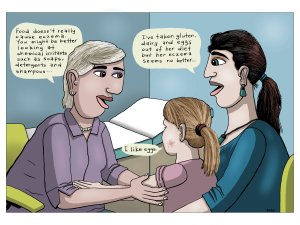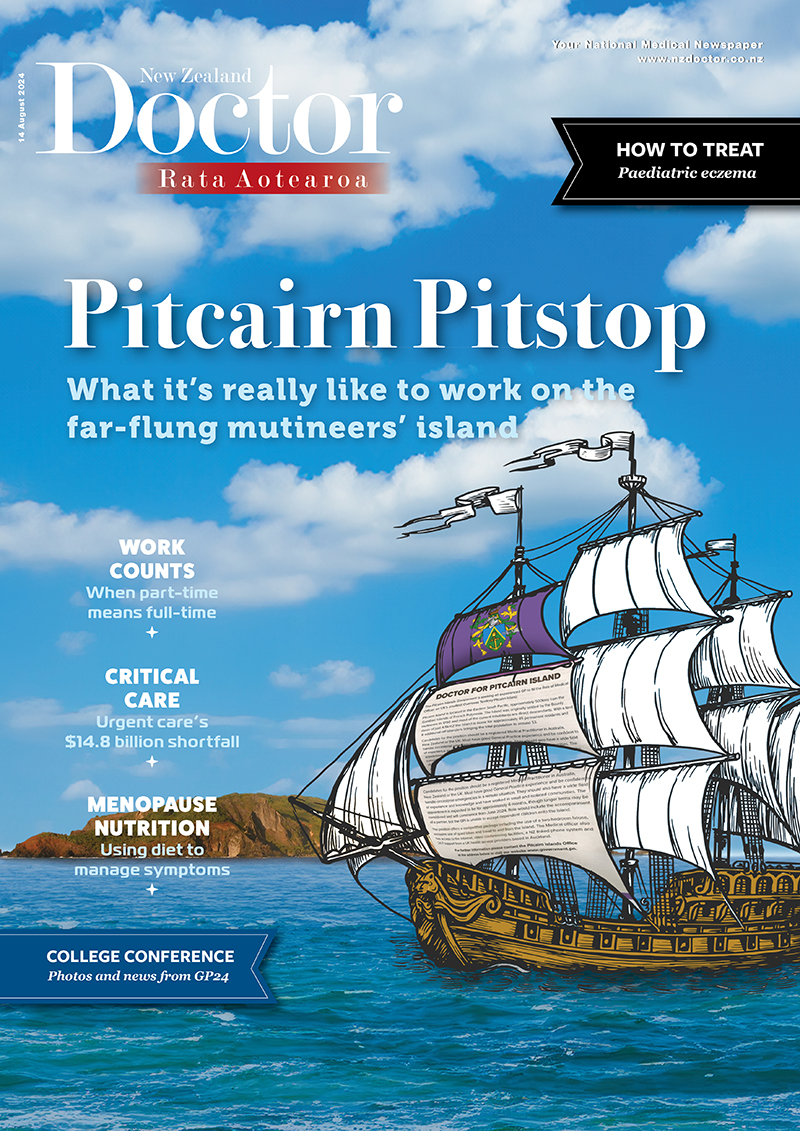Specialist GP Nikki Vadgama provides some tips to make your next paediatric eczema consult easier. She includes a review of new guidelines, resources, websites and medications for paediatric eczema management
Kāwhia calling
Kāwhia calling
Keira Stephenson meets a couple who set out in search of a rural general practice, found one in Kāwhia on the west coast of the North Island, and fell in love with their new home town
An hour and 20 minutes on a winding road from Hamilton will get you to the sleepy harbourside town of Kāwhia. It’s even longer if you take the potholed, loose metal Bridal Veil Falls road from the comparative “rat race” of Raglan.
The road that led Sue and John Burton to their general practice in Kāwhia was one of adventure – sweeping through the developing world in West Africa and traversing the length and breadth of New Zealand, before coming to a gentle stop in the picturesque town.
The contrast between the West African nation of Benin, where the doctor–patient ratio is about three to a million, and Kāwhia, with its one doctor for 300 people, is immense.
The longer we stay here, the deeper our relationship with our patients grows and fulfils our dream of being involved with the community
East Auckland-raised Dr Burton trained at Otago Medical School, then worked as a rural locum while completing the GP training scheme. This included a fortuitous year in Riverton, where he met Sue, who was living in Queenstown. The pair would meet in Fiordland National Park and go tramping.
After another year of rural locums, the couple, now married, volunteered in a three-doctor hospital in Benin for a year. While Sue, a medical technician, ran the hospital lab, managing four French-speaking locals, John did whatever he could, including surgeries he had never trained for.
With no technological resources and no consultants, he had to learn to do “all sorts of things I never dreamed of”.
By comparison, moving to a small, isolated rural town was not even remotely daunting.
Back when no one was job hunting in this way, the pair advertised their availability to work in rural practices, and received a tumult of replies. They narrowed their list down to 17 and visited them all, taking a trip across the country and staying with GPs in rural towns.
Kāwhia hadn’t even made it onto the list but, finding themselves with a spare couple of hours, they decided to visit.
The next morning, Dr Burton thought about some of the big busy practices he had visited, and how, if he chose Kāwhia, he would have more time with his patients and get the chance to learn more about Māori language and culture. He was sold.
“I knew I wasn’t going to be so overwhelmed by the workload that I couldn’t connect with the community and see patients on their own patch, not just in the medical centre,” he says.
That was 26 years ago.
With sunlight filtering through the bamboo blinds into a cluttered office lined with family photos, Dr Burton gives the appearance of a man who has found his calling, and has everything in hand.
Though the couple had said they would leave once their three children reached high school age, they found they had fallen in love with the place; the kids were happy to go to boarding school.
Prior to the Burtons, Kawhia Health Centre was owned by a string of international doctors doing two-year stints. The physical building is leased from the council. The foreign doctors would build up patient trust and then sell, Dr Burton says.
In comparison, he knows the history of every household in the town.
“The longer we stay here, the deeper our relationship with our patients grows and fulfils our dream of being involved with the community.”
John and Sue have seen the Kāwhia population drop dramatically, from 600 to 300. Dr Burton says, after 9/11, people decided Kāwhia would make an excellent future bolthole and bought up the cheap houses, displacing the locals.
It’s still a high-needs population with not much employment, but it’s also very resilient and people support each other, Dr Burton says. He is always on call but, because everyone knows him, people never abuse the after-hours system – to the point that someone with a broken femur waited until the next day to call.
The high unemployment rate also helps Kawhia Health Centre do a good job as a teaching practice. Because most patients aren’t rushing back to work, they are happy to take longer with the medical students.
Patients also know having students helps with staff recruitment, and they sometimes prefer an out-of-towner to confide in.
Feedback from students who have trained at the practice and been swept up in the life of the community is overwhelmingly positive, some doing U-turns from wanting to work in hospitals to becoming rural GPs.
One former student recently returned to provide cover while the Burtons took a six-month sabbatical, including time at the Northern Ontario School of Medicine in Canada. The focus there is on training and placing doctors in rural communities.
Not surprisingly, Dr Burton is a proponent of the Waikato rural medical school idea.
Kawhia Health Centre sees about 13 patients a day but, with no nurse, pharmacist, physio, lab or accident and medical centre, there is plenty to do.
No one who works at the practice has just one job. Sue does some reception, runs a cervical smear clinic and can take bloods. Heather Sherman, practice manager and receptionist, is also in charge of decorating the reception with artwork by children from the local school – where she also works as a secretary.
Another receptionist, Raewyn Sayers, also works in child cancer and does health coaching.
“One year, we had a medical graduate who took a year out to work as our receptionist,” Dr Burton says. “She did more surgery as a receptionist here, than as a house surgeon at Waikato [Hospital].”
The practice also employs nurse Donna Murray to visit patients at home – those who might need motivating, and those Dr Burton is concerned about. Because they know her, she can pick up on problems early.
Exercise classes with Sport Waikato volunteers are another point of community connection between practice and patients.
The community health worker model is something the Burtons took away from Benin. The local peasant farmers there were trained as spinal anaesthetists, and Dr Burton says they did a far better job than he would have done.
Receptionist Tui Anne Bishop-Hay is a great example of this. Dr Burton had naïvely thought people diagnosed with diabetes would understand they needed to see a GP, but this wasn’t the case. So, when Ms Bishop-Hay became interested in diabetes and had the support of some of the local elders, he encouraged her to go out on monthly rounds with a visiting diabetes specialist.
Just as with the mental health nurse they employed, having someone people knew meant they would agree to meet the specialist.
Ms Bishop-Hay then undertook diabetes training. Even while working in reception, she was diagnosing one or two people a week with diabetes.
As I prepare to leave Kāwhia, I visit the little art gallery in the same building as the practice. The artist enthuses about the charms of Kāwhia, especially compared with the rat race of Raglan.
When he discovers I have interviewed Dr Burton, he is pleased.
“You don’t get many like that,” he tells me.
“He still rides his bike to work every day and he’s been known to ride to home visits – you often see his bike parked outside people’s houses.
“Nothing is ever a problem for him.”
- Log in to post comments




